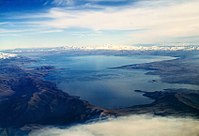
Photo from wikipedia
Abstract Research on eogenetic karsts has mostly focused on oceanic settings but rarely targeted lacustrine settings. This study describes an eogenetic karst formed in a saline lacustrine setting in the… Click to show full abstract
Abstract Research on eogenetic karsts has mostly focused on oceanic settings but rarely targeted lacustrine settings. This study describes an eogenetic karst formed in a saline lacustrine setting in the upper 4th member of the Shahejie Formation (Es4s), Dongying Depression, China. Limestones were deposited on a landmass-attached carbonate platform characterized by boundstones and grainstones interbedded with micrites. Tectonic uplift at the end of Es4s caused the karstification in a saline lake shore setting over approximately 2 Ma. During the exposure period, pervasive macroporosity developed in intervals within the top 20 m below the unconformity. Caves formed along the periphery of the platform, and they are mainly at 0.2-1.3 m in height and are filled with wackestone sediments without turbulent flow features. The caves are interpreted as the result of mixing dissolution on the margin of a mixing zone of saline lake-water and fresh-water. Sponge-like intervals occur in interior areas and range from 0.5 to 2.5 m in height, and they present a spongy porosity with pyrite crusts, pervasive pyrite framboid disseminations and occasional cements. The sponge-like dissolution pores are analogous to the Swiss-cheese texture forming in modern and fossil mixing zones and are probably caused by microbially-mediated dissolution in a mixing zone where mixing rate is limited because of reduced circulation in saline lake phreatic water. A small number of sub-vertical conduits (turbulent flow paths) and pervasive fissures are generated due to dissolution by meteoric water. The dissolution effects are strongly influenced by primary lithofacies. Spongy dissolution and caves develop almost in boundstone and grainstone layers, which is probably because they maintained a high permeability after shallow burial and thus become the preferential diffuse flow paths. According to this model, the boundstone and grainstone intervals developed along the periphery of the platform could be favorable reservoirs for future petroleum exploration.
Journal Title: Marine and Petroleum Geology
Year Published: 2020
Link to full text (if available)
Share on Social Media: Sign Up to like & get
recommendations!